The AMD Radeon R9 Fury X Review: Aiming For the Top
by Ryan Smith on July 2, 2015 11:15 AM ESTCompute
Shifting gears, we have our look at compute performance. As an FP64 card, the R9 Fury X only offers the bare minimum FP64 performance for a GCN product, so we won’t see anything great here. On the other hand with a theoretical FP32 performance of 8.6 TFLOPs, AMD could really clean house on our more regular FP32 workloads.
Starting us off for our look at compute is LuxMark3.0, the latest version of the official benchmark of LuxRender 2.0. LuxRender’s GPU-accelerated rendering mode is an OpenCL based ray tracer that forms a part of the larger LuxRender suite. Ray tracing has become a stronghold for GPUs in recent years as ray tracing maps well to GPU pipelines, allowing artists to render scenes much more quickly than with CPUs alone.
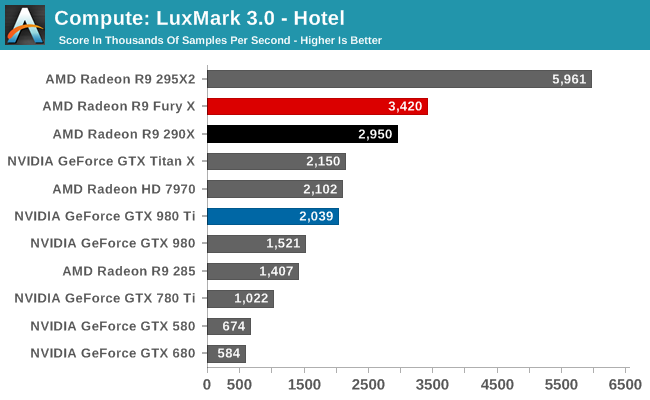
The results with LuxMark ended up being quite a bit of a surprise, and not for a good reason. Compute workloads are shader workloads, and these are workloads that should best illustrate the performance improvements of R9 Fury X over R9 290X. And yet while the R9 Fury X is the fastest single GPU AMD card, it’s only some 16% faster, a far cry from the 50%+ that it should be able to attain.
Right now I have no reason to doubt that the R9 Fury X is capable of utilizing all of its shaders. It just can’t do so very well with LuxMark. Given the fact that the R9 Fury X is first and foremost a gaming card, and OpenCL 1.x traction continues to be low, I am wondering whether we’re seeing a lack of OpenCL driver optimizations for Fiji.
For our second set of compute benchmarks we have CompuBench 1.5, the successor to CLBenchmark. CompuBench offers a wide array of different practical compute workloads, and we’ve decided to focus on face detection, optical flow modeling, and particle simulations.
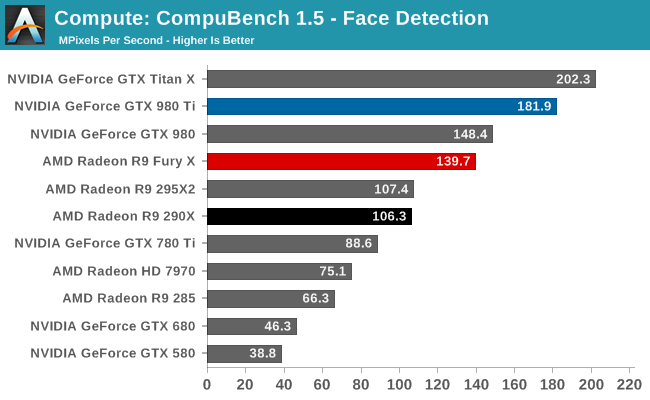
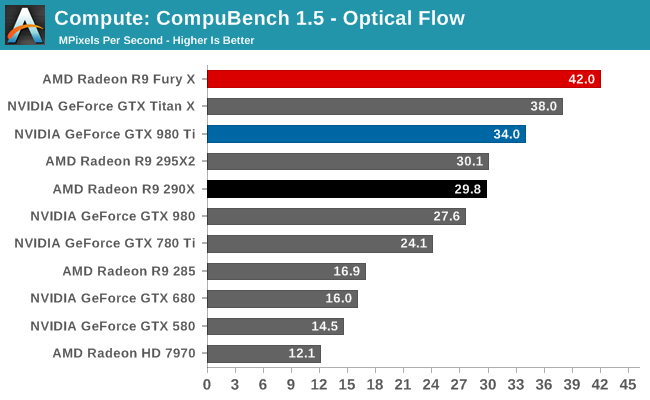

Quickly taking some of the air out of our driver theory, the R9 Fury X’s performance on CompuBench is quite a bit better, and much closer to what we’d expect given the hardware of the R9 Fury X. The Fury X only wins overall at Optical Flow, a somewhat memory-bandwidth heavy test that to no surprise favors AMD’s HBM additions, but otherwise the performance gains across all of these tests are 40-50%. Overall then the outcome over who wins is heavily test dependent, though this is nothing new.
Our 3rd compute benchmark is Sony Vegas Pro 13, an OpenGL and OpenCL video editing and authoring package. Vegas can use GPUs in a few different ways, the primary uses being to accelerate the video effects and compositing process itself, and in the video encoding step. With video encoding being increasingly offloaded to dedicated DSPs these days we’re focusing on the editing and compositing process, rendering to a low CPU overhead format (XDCAM EX). This specific test comes from Sony, and measures how long it takes to render a video.
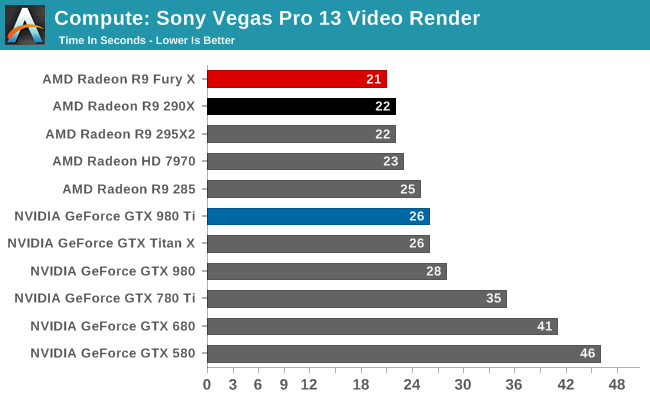
At this point Vegas is becoming increasingly CPU-bound and will be due for replacement. The Fury X none the less shaves off an additional second of rendering time, bringing it down to 21 seconds.
Moving on, our 4th compute benchmark is FAHBench, the official Folding @ Home benchmark. Folding @ Home is the popular Stanford-backed research and distributed computing initiative that has work distributed to millions of volunteer computers over the internet, each of which is responsible for a tiny slice of a protein folding simulation. FAHBench can test both single precision and double precision floating point performance, with single precision being the most useful metric for most consumer cards due to their low double precision performance. Each precision has two modes, explicit and implicit, the difference being whether water atoms are included in the simulation, which adds quite a bit of work and overhead. This is another OpenCL test, utilizing the OpenCL path for FAHCore 17.
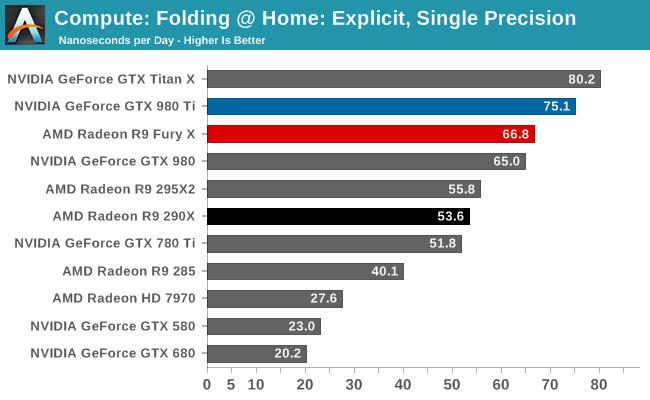

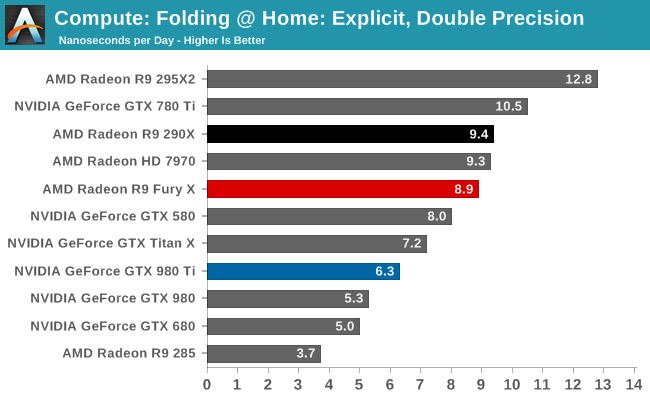
Both of the FP32 tests for FAHBench show smaller than expected performance gains given the fact that the R9 Fury X has such a significant increase in compute resources and memory bandwidth. 25% and 34% respectively are still decent gains, but they’re smaller gains than anything we saw on CompuBench. This does lend a bit more support to our theory about driver optimizations, though FAHBench has not always scaled well with compute resources to begin with.
Meanwhile FP64 performance dives as expected. With a 1/16 rate it’s not nearly as bad as the GTX 900 series, but even the Radeon HD 7970 is beating the R9 Fury X here.
Wrapping things up, our final compute benchmark is an in-house project developed by our very own Dr. Ian Cutress. SystemCompute is our first C++ AMP benchmark, utilizing Microsoft’s simple C++ extensions to allow the easy use of GPU computing in C++ programs. SystemCompute in turn is a collection of benchmarks for several different fundamental compute algorithms, with the final score represented in points. DirectCompute is the compute backend for C++ AMP on Windows, so this forms our other DirectCompute test.
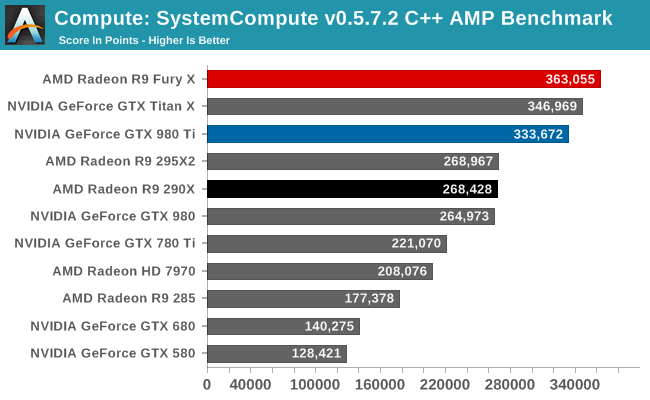
Our C++ AMP benchmark is another case of decent, though not amazing, GPU compute performance gains. The R9 Fury X picks up 35% over the R9 290X. And in fact this is enough to vault it over NVIDIA’s cards to retake the top spot here, though not by a great amount.










458 Comments
View All Comments
D. Lister - Thursday, July 2, 2015 - link
"AMD had tessellation years before nVidia, but it went unused until DX11, by which time nVidia knew AMD's capabilities and intentionally designed a way to stay ahead in tessellation. AMD's own technology being used against it only because it released it so early. HBM, I fear, will be another example of this. AMD helped to develop HBM and interposer technologies and used them first, but I bet nVidia will benefit most from them."AMD is often first at announcing features. Nvidia is often first at implementing them properly. It is clever marketing vs clever engineering. At the end of the day, one gets more customers than the other.
sabrewings - Thursday, July 2, 2015 - link
While you're right that Nvidia paid for the chips used in 980 Tis, they're still most likely not fit for Titan X use and are cut to remove the underperforming sections. Without really knowing what their GM200 yields are like, I'd be willing to be the $1000 price of the Titan X was already paying for the 980 Ti chips. So, Nvidia gets to play with binned chips to sell at $650 while AMD has to rely on fully up chips added to an expensive interposer with more expensive memory and a more expensive cooling solution to meet the same price point for performance. Nvidia definitely forced AMD into a corner here, so as I said I would say they won.Though, I don't necessarily say that AMD lost, they just make it look much harder to do what Nvidia was already doing and making bookoo cash at that. This only makes AMD's problems worse as they won't get the volume to gain marketshare and they're not hitting the margins needed to heavily reinvest in R&D for the next round.
Kutark - Friday, July 3, 2015 - link
So basically what you're saying is Nvidia is a better run company with smarter people working there.squngy - Friday, July 3, 2015 - link
"and they cost more per chip to produce than AMD's Fiji GPU."Unless AMD has a genie making it for them that's impossible.
Not only is fiji larger, it also uses a totally new technology (HBM).
JumpingJack - Saturday, July 4, 2015 - link
"AMD had tessellation years before nVidia, but it went unused until DX11, by which time nVidia knew AMD's capabilities and intentionally designed a way to stay ahead in tessellation. AMD's own technology being used against it only because it released it so early. HBM, I fear, will be another example of this. AMD helped to develop HBM and interposer technologies and used them first, but I bet nVidia will benefit most from them."AMD fanboys make it sound like AMD can actually walk on water. AMD did work with Hynix, but the magic of HBM comes in the density from die stacking, which AMD did nothing (they are no longer the actual chipmaker as you probably know). As for interposers, this is not new technology, interposers are well established techniques for condensing an array of devices into one package.
AMD deserves credit for bringing the technology to market, no doubt, but their actually IP contribution is quite small.
ianmills - Thursday, July 2, 2015 - link
Good that you are feeling better Ryan and thanks for the review :)That being said Anandtech needs keep us better informed when things come up.... The way this site handled it though is gonna lose this site readers...
Kristian Vättö - Thursday, July 2, 2015 - link
Ryan tweeted about the Fiji schedule several times and we were also open about it in the comments whenever someone asked, even though it wasn't relevant to the article in question. It's not like we were secretive about it and I think a full article of an article delay would be a little overkill.sabrewings - Thursday, July 2, 2015 - link
Those tweets are even featured on the site in the side bar. Not sure how much clearer it could get without an article about a delayed article.testbug00 - Sunday, July 5, 2015 - link
Pipeline story... Dunno title, but, for text, explain it there. Have a link to THG as owned by same company now if readers want to read a review immediately.Twitter is non-ideal.
funkforce - Monday, July 6, 2015 - link
The problem isn't only with the delays, it is that since Ryan took over as Editor in Chief I suspect his workload is too large.Because this also happened with the Nvidia GTX 960 review. He told 5-6 people (including me) for 5 weeks that it would come, and then it didn’t and he stopped responding to inquires about it.
Now in what way is that a good way to build a good relationship and trust between you and your readers?
I love Ryan's writing, this article was one of the best I've read in a long time. But not everyone is good at everything, maybe Ryan needs to focus on only GPU reviews and not running the site or whatever his other responsibilities are as Edit. in Chief.
Because the Reviews are what most ppl. come here for and what built this site. You guys are amazing, but AT never used to miss releasing articles the same day NDA was lifted in the past that I can remember. And promising things and then not delivering, sticking your head in the sand and not even apologizing isn’t a way to build up trust and uphold and strengthen the large following this site has.
I love this site, been reading it since the 1st year it came out, and that's why I care and I want you to continue and prosper.
Since a lot of ppl. can’t reed the twitter feed then what you did here: http://www.anandtech.com/show/8923/nvidia-launches...
Is the way to go if something comes up, but then you have to deliver on your promises.